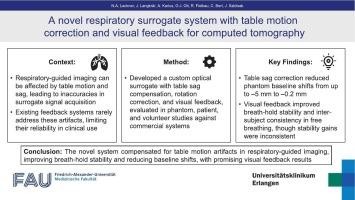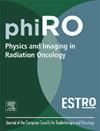一种具有桌面运动校正和视觉反馈的新型呼吸替代系统
IF 3.3
Q2 ONCOLOGY
引用次数: 0
摘要
背景与目的CT放射治疗中呼吸运动的管理是至关重要的。临床替代系统和视觉指导可能由于桌面移动或凹陷而出现不准确性,限制了深度吸气屏气(DIBH) CT和四维CT (4DCT)的有效性。本研究评估了一种运动矫正的新型替代和反馈系统,以改善DIBH和4DCT呼吸质量。材料和方法反馈系统在增加载荷(高达104 kg)下的工作台凹陷补偿模拟试验中进行了评估。对患者进行DIBH平台稳定性指标(n = 2)和4DCT基线偏移(n = 3)的评估。在一项志愿者研究中(n = 10),比较DIBH和4DCT情景下的音频和视觉反馈,分别评估屏气稳定性和呼吸规律性。结果在假体测量中,在最大负荷下,工作台凹陷对呼吸信号的影响有效降低,基线移位限制在- 0.2 mm,而在临床系统中可达- 5 mm。在患者中,该系统改善了DIBH信号的稳定性,反映在平台漂移上(- 0.2 mm/s vs. - 0.8 mm/s),与临床系统(- 1.7±0.3 mm)相比,该系统大大减少了4DCT的基线漂移(- 0.2±0.2 mm)。志愿者测试表明,视觉反馈改善了DIBH的再现性(标准偏差:0.5 mm vs.音频反馈1.1 mm)。在4DCT场景中,视觉反馈统一了不规则呼吸者,但没有提供比音频指导一致的改善。结论该系统补偿了幻影、患者和志愿者的桌面运动测量。在反馈场景下,它在DIBH中表现良好,而在4DCT中的性能需要进一步优化。本文章由计算机程序翻译,如有差异,请以英文原文为准。

A novel respiratory surrogate system with table motion correction and visual feedback for computed tomography
Background and purpose
Managing respiratory motion is crucial for computed tomography (CT) in radiotherapy. Clinical surrogate systems and visual coaching can exhibit inaccuracies due to table motion or sag, limiting effectiveness in deep inspiration breath-hold (DIBH) CT and four-dimensional CT (4DCT). This study evaluated a motion-corrected novel surrogate and feedback system to improve DIBH and 4DCT breathing quality.
Materials and methods
The feedback system was evaluated in phantom tests for table sag compensation under incremental loads (up to 104 kg). For patients, DIBH plateau stability metrics (n = 2) and baseline shifts in 4DCT (n = 3) were assessed. In a volunteer study (n = 10), audio and visual feedback were compared in DIBH and 4DCT scenarios, assessing breath-hold stability and breathing regularity, respectively.
Results
In phantom measurements, the impact of table sag on the breathing signal was effectively reduced at maximum load, with baseline shifts limited to −0.2 mm, compared to up to −5 mm in clinical systems. In patients, the system improved DIBH signal stability, as reflected in the plateau drift (−0.2 mm/s vs. −0.8 mm/s), and substantially reduced baseline shifts in 4DCT (−0.2 ± 0.2 mm) when compared to clinical systems (−1.7 ± 0.3 mm). Volunteer tests demonstrated improved DIBH reproducibility with visual feedback (standard deviation: 0.5 mm vs. 1.1 mm with audio feedback). In 4DCT scenarios, visual feedback unified irregular breathers but offered no consistent improvement over audio guidance.
Conclusion
The novel system compensated for table motion in phantom, patient, and volunteer measurements. In feedback scenarios, it performed well in DIBH, while its performance in 4DCT requires further optimization.
求助全文
通过发布文献求助,成功后即可免费获取论文全文。
去求助
来源期刊

Physics and Imaging in Radiation Oncology
Physics and Astronomy-Radiation
CiteScore
5.30
自引率
18.90%
发文量
93
审稿时长
6 weeks
 求助内容:
求助内容: 应助结果提醒方式:
应助结果提醒方式:


